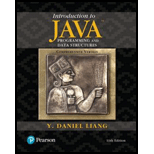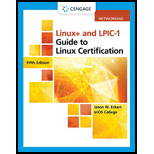
Introduction to Java Programming and Data Structures, Comprehensive Version Plus MyProgrammingLab with Pearson EText -- Access Card Package
11th Edition
ISBN: 9780134694511
Author: Liang, Y. Daniel
Publisher: Pearson Education Canada
expand_more
expand_more
format_list_bulleted
Question
Chapter 28, Problem 28.16PE
Program Plan Intro
Induced subgraph
Program Plan:
- Create a package “main”.
- Add a java class named “Edge” to the package which is used to get the edges from the graph.
- Add a java class named “Graph” to the package which is used to add and remove vertices, edges.
- Add a java class named “UnweightedGraph” to the package which is used to store vertices and neighbors.
- Add a java class named “WeightedGraph” to the package which is used to get the weighted edges and print the edges.
- Add a java class named “WeightedEdge” to the package which is used to compare edges.
- Add a java class named “E16” to the package.
- Import the required packages.
- Declare the main class.
- Give the “main ()” method.
- Declare the string array that contains the names of the city.
- Declare an integer array that contains the weight.
- Create an object for unweighted graph.
- Print the size of the graph, vertex of the graph, index of the vertex “Miami”, and the edges of the graph.
- Call the function “maxInducedSubgraph ()”.
- Print the size of the graph, vertex of the graph, index of the vertex “Miami”, and the edges of the graph.
- Give function definition for “maxInducedSubgraph ()”.
- Declare required variables
- Do until the condition “(!Isdone && g.getSize() > 0)” fails.
- Assign “true” to the variable.
- Loop from 0 through size.
- Check the condition “(g.getDegree(i) < k)”.
- Call the function “remove_Vertex ()”.
- Assign false to the variable.
- Break the loop.
- Check the condition “(g.getDegree(i) < k)”.
- Return the graph.
- Function definition for “UnweightedGraphInducedSubgraph ()”.
- Construct the empty graph.
- Construct a graph from vertices and edges stored in arrays.
- Get the vertices and edges.
- Construct a graph from vertices and edges stored in List.
- Get the vertices and edges.
- Construct a graph for integer vertices 0, 1, 2 and edge list.
- Get the vertices and edges.
- Construct a graph from integer vertices 0, 1, and edge array.
- Get the vertices and edges.
- Give function definition for “remove_Vertex ()”.
- Check the condition “(vertices.contains(v))”.
- Get the index.
- Call the functions “vertices.remove ()”, and “neighbors.remove ()”.
- Loop to remove the edges.
- Loop from 0 through size.
- Check the condition “(list.get(i).v == index)”. If it is true then remove the edge.
- Else, increment the variable
- Loop from 0 through size.
- Loop to reassign the labels.
- Loop from 0 through size.
- Check the condition “(list.get(i).u >= index)”. If the condition is true then get the edge
- Check the condtion “(list.get(i).v >= index)”. If the condition is true then get the edge
- Loop from 0 through size.
- Return “true”.
- Else,
- Return “false”.
- Check the condition “(vertices.contains(v))”.
- Give the “main ()” method.
Expert Solution & Answer
Want to see the full answer?
Check out a sample textbook solution
Students have asked these similar questions
Write the SQL code that permits to implement the tables: Student and Transcript. NB: Add the constraints on the attributes – keys and other.
Draw an ERD that will involve the entity types: Professor, Student, Department and Course. Be sure to add relationship types, key attributes, attributes and multiplicity on the ERD.
Draw an ERD that represents a book in a library system. Be sure to add relationship types, key attributes, attributes and multiplicity on the ERD.
Chapter 28 Solutions
Introduction to Java Programming and Data Structures, Comprehensive Version Plus MyProgrammingLab with Pearson EText -- Access Card Package
Ch. 28.2 - What is the famous Seven Bridges of Knigsberg...Ch. 28.2 - Prob. 28.2.2CPCh. 28.2 - Prob. 28.2.3CPCh. 28.2 - Prob. 28.2.4CPCh. 28.3 - Prob. 28.3.1CPCh. 28.3 - Prob. 28.3.2CPCh. 28.4 - Prob. 28.4.1CPCh. 28.4 - Prob. 28.4.2CPCh. 28.4 - Show the output of the following code: public...Ch. 28.4 - Prob. 28.4.4CP
Ch. 28.5 - Prob. 28.5.2CPCh. 28.6 - Prob. 28.6.1CPCh. 28.6 - Prob. 28.6.2CPCh. 28.7 - Prob. 28.7.1CPCh. 28.7 - Prob. 28.7.2CPCh. 28.7 - Prob. 28.7.3CPCh. 28.7 - Prob. 28.7.4CPCh. 28.7 - Prob. 28.7.5CPCh. 28.8 - Prob. 28.8.1CPCh. 28.8 - When you click the mouse inside a circle, does the...Ch. 28.8 - Prob. 28.8.3CPCh. 28.9 - Prob. 28.9.1CPCh. 28.9 - Prob. 28.9.2CPCh. 28.9 - Prob. 28.9.3CPCh. 28.9 - Prob. 28.9.4CPCh. 28.10 - Prob. 28.10.1CPCh. 28.10 - Prob. 28.10.2CPCh. 28.10 - Prob. 28.10.3CPCh. 28.10 - If lines 26 and 27 are swapped in Listing 28.13,...Ch. 28 - Prob. 28.1PECh. 28 - (Create a file for a graph) Modify Listing 28.2,...Ch. 28 - Prob. 28.3PECh. 28 - Prob. 28.4PECh. 28 - (Detect cycles) Define a new class named...Ch. 28 - Prob. 28.7PECh. 28 - Prob. 28.8PECh. 28 - Prob. 28.9PECh. 28 - Prob. 28.10PECh. 28 - (Revise Listing 28.14, NineTail.java) The program...Ch. 28 - (Variation of the nine tails problem) In the nine...Ch. 28 - (4 4 16 tails problem) Listing 28.14,...Ch. 28 - (4 4 16 tails analysis) The nine tails problem in...Ch. 28 - (4 4 16 tails GUI) Rewrite Programming Exercise...Ch. 28 - Prob. 28.16PECh. 28 - Prob. 28.17PECh. 28 - Prob. 28.19PECh. 28 - (Display a graph) Write a program that reads a...Ch. 28 - Prob. 28.21PECh. 28 - Prob. 28.22PECh. 28 - (Connected rectangles) Listing 28.10,...Ch. 28 - Prob. 28.24PECh. 28 - (Implement remove(V v)) Modify Listing 28.4,...Ch. 28 - (Implement remove(int u, int v)) Modify Listing...
Knowledge Booster
Similar questions
- 2:21 m Ο 21% AlmaNet WE ARE HIRING Experienced Freshers Salesforce Platform Developer APPLY NOW SEND YOUR CV: Email: hr.almanet@gmail.com Contact: +91 6264643660 Visit: www.almanet.in Locations: India, USA, UK, Vietnam (Remote & Hybrid Options Available)arrow_forwardProvide a detailed explanation of the architecture on the diagramarrow_forwardhello please explain the architecture in the diagram below. thanks youarrow_forward
- Complete the JavaScript function addPixels () to calculate the sum of pixelAmount and the given element's cssProperty value, and return the new "px" value. Ex: If helloElem's width is 150px, then calling addPixels (hello Elem, "width", 50) should return 150px + 50px = "200px". SHOW EXPECTED HTML JavaScript 1 function addPixels (element, cssProperty, pixelAmount) { 2 3 /* Your solution goes here *1 4 } 5 6 const helloElem = document.querySelector("# helloMessage"); 7 const newVal = addPixels (helloElem, "width", 50); 8 helloElem.style.setProperty("width", newVal); [arrow_forwardSolve in MATLABarrow_forwardHello please look at the attached picture. I need an detailed explanation of the architecturearrow_forward
- Information Security Risk and Vulnerability Assessment 1- Which TCP/IP protocol is used to convert the IP address to the Mac address? Explain 2-What popular switch feature allows you to create communication boundaries between systems connected to the switch3- what types of vulnerability directly related to the programmer of the software?4- Who ensures the entity implements appropriate security controls to protect an asset? Please do not use AI and add refrencearrow_forwardFind the voltage V0 across the 4K resistor using the mesh method or nodal analysis. Note: I have already simulated it and the value it should give is -1.714Varrow_forwardResolver por superposicionarrow_forward
- Describe three (3) Multiplexing techniques common for fiber optic linksarrow_forwardCould you help me to know features of the following concepts: - commercial CA - memory integrity - WMI filterarrow_forwardBriefly describe the issues involved in using ATM technology in Local Area Networksarrow_forward
arrow_back_ios
SEE MORE QUESTIONS
arrow_forward_ios
Recommended textbooks for you
 C++ Programming: From Problem Analysis to Program...Computer ScienceISBN:9781337102087Author:D. S. MalikPublisher:Cengage Learning
C++ Programming: From Problem Analysis to Program...Computer ScienceISBN:9781337102087Author:D. S. MalikPublisher:Cengage Learning LINUX+ AND LPIC-1 GDE.TO LINUX CERTIF.Computer ScienceISBN:9781337569798Author:ECKERTPublisher:CENGAGE L
LINUX+ AND LPIC-1 GDE.TO LINUX CERTIF.Computer ScienceISBN:9781337569798Author:ECKERTPublisher:CENGAGE L EBK JAVA PROGRAMMINGComputer ScienceISBN:9781337671385Author:FARRELLPublisher:CENGAGE LEARNING - CONSIGNMENT
EBK JAVA PROGRAMMINGComputer ScienceISBN:9781337671385Author:FARRELLPublisher:CENGAGE LEARNING - CONSIGNMENT Microsoft Visual C#Computer ScienceISBN:9781337102100Author:Joyce, Farrell.Publisher:Cengage Learning,
Microsoft Visual C#Computer ScienceISBN:9781337102100Author:Joyce, Farrell.Publisher:Cengage Learning, EBK JAVA PROGRAMMINGComputer ScienceISBN:9781305480537Author:FARRELLPublisher:CENGAGE LEARNING - CONSIGNMENT
EBK JAVA PROGRAMMINGComputer ScienceISBN:9781305480537Author:FARRELLPublisher:CENGAGE LEARNING - CONSIGNMENT C++ for Engineers and ScientistsComputer ScienceISBN:9781133187844Author:Bronson, Gary J.Publisher:Course Technology Ptr
C++ for Engineers and ScientistsComputer ScienceISBN:9781133187844Author:Bronson, Gary J.Publisher:Course Technology Ptr

C++ Programming: From Problem Analysis to Program...
Computer Science
ISBN:9781337102087
Author:D. S. Malik
Publisher:Cengage Learning

LINUX+ AND LPIC-1 GDE.TO LINUX CERTIF.
Computer Science
ISBN:9781337569798
Author:ECKERT
Publisher:CENGAGE L

EBK JAVA PROGRAMMING
Computer Science
ISBN:9781337671385
Author:FARRELL
Publisher:CENGAGE LEARNING - CONSIGNMENT

Microsoft Visual C#
Computer Science
ISBN:9781337102100
Author:Joyce, Farrell.
Publisher:Cengage Learning,

EBK JAVA PROGRAMMING
Computer Science
ISBN:9781305480537
Author:FARRELL
Publisher:CENGAGE LEARNING - CONSIGNMENT

C++ for Engineers and Scientists
Computer Science
ISBN:9781133187844
Author:Bronson, Gary J.
Publisher:Course Technology Ptr